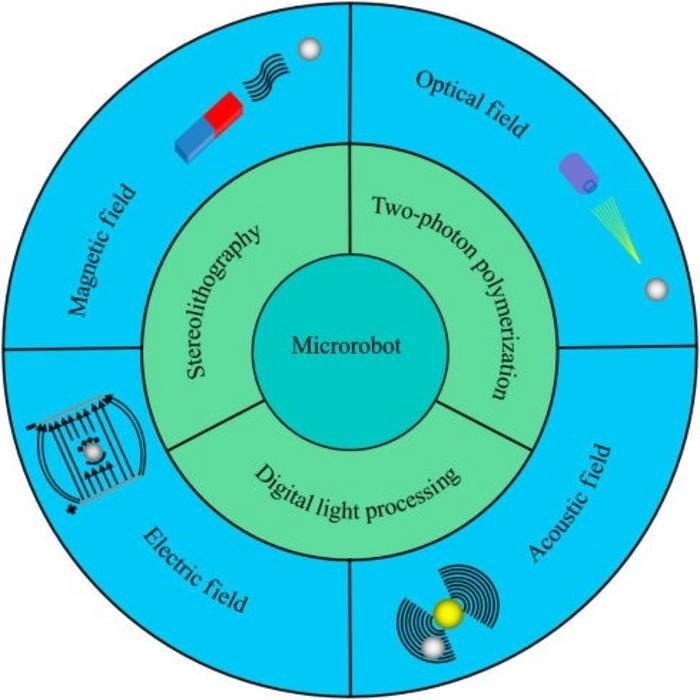At the Beijing Institute of Technology, a review paper presented by researchers outlined the recent research performed on field-controlled microrobots that have been fabricated by photopolymerization.

Scientists from Beijing Institute of Technology summarized the recent research on field-controlled microrobots fabricated by photopolymerization. Image Credit: Xiyue Liang, Beijing Institute of Technology
The new review paper offered an overview of the photopolymerization technologies that have been used in the fabrication of field-controlled microrobots and initiated the photopolymerized microrobots actuated by various field forces and their functions.
The study was reported in the journal Cyborg and Bionic Systems on June 6th, 2023.
Field-controlled microrobots have attracted extensive research in the biological and medical fields due to the prominent characteristics including high flexibility, small size, strong controllability, remote manipulation, and minimal damage to living organisms.
Xiaoming Liu, Study Author and Professor, Beijing Institute of Technology
In the biomedical field, microrobots have turned out to be one of the most hopeful tools as a result of their high abilities of targeted therapy, minimally invasive surgery, and cell manipulation.
“Employing photopolymerization in the fabrication of field-controlled microrobots provides an ideal solution,” stated the study authors.
Hence, they reviewed the photopolymerization technologies used in the fabrication of field-controlled microrobots and further initiated the photopolymerized microrobots that have been actuated by various field forces and their functions.
Photopolymerization technology encourages the advancement of field-controlled microrobots in several terms, such as manipulation accuracy, size, function, and flexibility.
The requirements on the structure, material, and size of field-controlled microrobots also positively accelerate the development of photopolymerization technology.
Xiaoming Liu, Study Author and Professor, Beijing Institute of Technology
The latest developments were discussed by the study authors in actuating microrobots through optical, magnetic, acoustic, and electric fields and the respectively used photopolymerization techniques. Microrobots are regulated by optical tweezers; for instance, the joint microrobot built on two-photon polymerization allows indirect manipulation of biological cells.
Going ahead, the key future developing directions of the field-controlled microrobots have been fabricated by photopolymerization, such as the smart materials and abilities for real applications.
Furthermore, the development of field-assisted photopolymerization technology might enhance the producibility of complicated designs and multi-material fabricating abilities.
Also, it is crucial to choose ideal and effective control techniques to fulfill the needs of complicated environments and tasks in vivo clinical. Collaborative control of microrobots via several combinations of physics might be a feasible method.
The improvement of printing technology, the development of new materials, and the rational design of multiple control methods, field-controlled microrobots fabricated by photopolymerization with better performance will usher in vigorous development.
Xiaoming Liu, Study Author and Professor, Beijing Institute of Technology
The review paper needs engineers, researchers, medical professionals, and other experts to jointly assemble the research on field-controlled microrobots that have been fabricated by photopolymerization into practical applications in clinical settings.
The study authors include Xiyue Liang, Zhuo Chen, Yan Deng, Dan Liu, Xiaoming Liu, Qiang Huang, and Tatsuo Arai.
The study was financially supported by the National Natural Science Foundation of China under grants 62273052, 61873037, and 61903039; and the National Key R&D Program of China (2017YFA0701102).
Journal Reference
Liang, X., et al. (2023) Field-Controlled Microrobots Fabricated by Photopolymerization. Cyborg and Bionic Systems. doi.org/10.34133/cbsystems.0009.